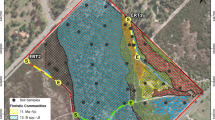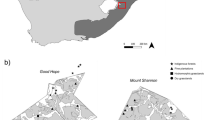Abstract
The harsh climate and patchy distribution of habitable terrestrial ecosystems constrain soil invertebrate communities in continental Antarctica. The Windmill Islands in East Antarctica have a relatively gentle climate by Antarctic standards, and the region supports some of the most well-developed moss beds on the continent. These moss beds and soils are known to sustain invertebrate communities dominated by nematodes, rotifers and tardigrades, but our knowledge of the diversity and composition of these communities remains limited. We extracted soil fauna from 74 soil samples representing a wide range of microhabitats, and 24 moss samples, collected at Clark Peninsula, Bailey Peninsula and Robinson Ridge in the Windmill Islands during the 2012–2013 austral summer. Invertebrates were present in all samples, but densities varied considerably both within and between sites with limited correlation with edaphic variables or cover type. Taxa found included two species of nematodes (Plectus murrayi; Plectus frigophilus), one mite (Nanorchestes antarcticus) as well as tardigrades and rotifers (enumerated only). No springtails were found in this study, but individuals of the genus Cryptopygus were later recovered from moss collected near Casey Station. The Windmill Islands soils and moss beds support dense populations of soil fauna. However, despite the relatively mild climate conditions and favorable soil properties, species diversity is low. The diversity is possibly limited by recent deglaciation and limited dispersal opportunities to the region. Given favorable local conditions, it is likely that colonizing species will perform well, whether these arrive by natural means or are accidentally introduced by humans.


Similar content being viewed by others
References
Adams BJ, Bardgett RD, Ayres E, Wall DH, Aislabie J, Bamforth S, Bargagli R, Cary C, Cavacini P, Connell L, Convey P, Fell JW, Frati F, Hogg ID, Newsham KK, O’Donnell A, Russell N, Seppelt RD, Stevens MI (2006) Diversity and distribution of Victoria Land biota. Soil Biol Biochem 38:3003–3018
Andrássy I (2008) On the male of the Antarctic nematode species, Plectus murrayi Yeates, 1970. J Nematode Morphol Syst 11:87–89
Azmi OR, Seppelt RD (1998) The broad-scale distribution of microfungi in the Windmill Islands region, continental Antarctica. Polar Biol 19:92–100
Barrett JE, Virginia RA, Wall DH, Cary SC, Adams BJ, Hacker AL, Aislabie JM (2006) Co-variation in soil biodiversity and biogeochemistry in northern and southern Victoria Land, Antarctica. Antarct Sci 18:535–548
Beyer L, Bölter M, Seppelt RD (2000) Nutrient and thermal regime, microbial biomass, and vegetation of Antarctic soils in the Windmill Islands region of east Antarctica (Wilkes Land). Arct Antarct Alp Res 32:30–39
Blight DF, Oliver RL (1977) The metamorphic geology of the Windmill Islands, Antarctica: a preliminary account. J Geol Soc Aust 24:239–262
Bokhorst S, Huiskes A, Convey P, van Bodegom PM, Aerts R (2008) Climate change effects on soil arthropod communities from the Falkland Islands and the Maritime Antarctic. Soil Biol Biochem 40:1547–1556
Bracegirdle TJ, Connolley WM, Turner J (2008) Antarctic climate change over the twenty-first century. J Geophys Res 133:D03103. doi:10.1029/2007JD008933
Chong CW, Tan GYA, Wong RCS, Riddle MJ, Tan IKP (2009) DGGE fingerprinting of bacteria in soils from eight ecologically different sites around Casey Station, Antarctica. Polar Biol 32:853–860
Chown SL, Huiskes AHL, Gremmen NJM, Lee JE, Terauds A, Crosbied K, Frenot Y, Hughes KA, Imura S, Kiefer K, Lebouvier M, Raymond B, Tsujimoto M, Ware C, Van de Vijver B, Bergstrom DM (2012) Continent-wide risk assessment for the establishment of nonindigenous species in Antarctica. Proc Natl Acad Sci USA 109:4938–4943
Convey P, Chown SL, Clarke A, Barnes DKA, Bokhorst S, Cummings V, Ducklow HW, Frati F, Allan Green TG, Gordon S, Griffiths HJ, Howard-Williams C, Huiskes AHL, Laybourn-Parry J, Lyons WB, McMinn A, Morley SA, Peck LS, Quesada A, Robinson SA, Schiaparelli S, Wall DH (2014) The spatial structure of Antarctic biodiversity. Ecol Monogr 84:203–244
Cromer L, Gibson JAE, Swadling KM, Hodgson DA (2006) Evidence for a lacustrine faunal refuge in the Larsemann Hills, East Antarctica, during the Last Glacial Maxima. J Biogeogr 33:1314–1323
Davis RC (1981) Structure and function of two Antarctic terrestrial moss communities. Ecol Monogr 51:125–143
Day TA, Ruhland CT, Strauss SL, Park J-H, Krieg ML, Krna MA, Bryant DM (2009) Responses of plants and the dominant microarthropod, Cryptopygus antarcticus, to warming and contrasting precipitation regimes in Antarctic tundra. Glob Change Biol 15:1640–1651
Frenot Y, Chown SL, Whinam J, Selkirk PM, Convey P, Skotnicki M, Bergstrom DM (2005) Biological invasions in the Antarctic: extent, impacts and implications. Biol Rev 80:45–72
Goodwin I (1993) Holocene deglaciation, sea level change, and the emergence of the Windmill Islands, Budd Coast, Antarctica. Quat Res 40:70–80
Heatwole H, Saenger P, Spain A, Kerry E, Donelan J (1989) Biotic and chemical characteristics of some soils from Wilkes Land, Antarctica. Antarct Sci 1:225–234
Hogg ID, Stevens M (2002) Soil fauna of Antarctic coastal landscapes. In: Beyer L, Bölter M (eds) Geoecology of Antarctic ice-free coastal landscapes. Ecological studies, vol 154. Springer, Berlin, pp 265–282
Hogg ID, Cary C, Convey P, Newsham KK, O’Donnell AG, Adams BJ, Aislabie J, Frati F, Stevens M, Wall DH (2006) Biotic interactions in Antarctic terrestrial ecosystems: are they a factor? Soil Biol Biochem 38:3035–3040
Hollin JT, Cameron RL (1961) I.G.Y. glaciological work at Wilkes Station, Antarctica. J Glaciol 3:833–843
Howard-Williams C, Hawes I, Gordon S (2010) The environmental basis of ecosystem variability in Antarctica: research in the latitudinal Gradient project. Antarct Sci 22:591–602
Hughes KA, Pertierra LR, Molina-Montenegro MA, Convey P (2015) Biological invasions in terrestrial Antarctica: what is the current status and can we respond? Biodivers Conserv. doi:10.1007/s10531-015-0896-6
Huiskes AHL, Convey P, Bergstrom DM (2006) Trends in Antarctic terrestrial and limnetic ecosystems. In: Bergstrom DM, Convey P, Huiskes AHL (eds) Trends in Antarctic terrestrial and limnetic ecosystems: Antarctica as a global indicator. Springer, Dordrecht, pp 1–13
Kito K, Ohyama Y (2008) Rhabditid nematodes found from a rocky coast contaminated with treated wastewater of Casey Station in East Antarctica, with a description of a new species of Dolichorhabditis Andrassy, 1983 (Nematoda: Rhabditidae). Zootaxa 1850:43–52
Lewis Smith RI (1986) Plant ecological studies in the fellfield ecosystem near Casey Station, Australian Antarctic Territory, 1985–86. Br Antarct Surv Bull 72:81–91
Mackintosh AN, Verleyen E, O’Brien PE, White DA, Jones RS, McKay R, Dunbar R, Gore DB, Fink D, Post AL, Miura H, Leventer A, Goodwin I, Hodgson DA, Lilly K, Crosta X, Golledge NR, Wagner B, Berg S, van Ommen T, Zwartz D, Roberts SJ, Vyvermann W, Masse G (2014) Retreat history of the East Antarctic ice sheet since the last glacial maximum. Quat Sci Rev 100:10–30
Melick DR, Seppelt RD (1994) Seasonal investigations of soluble carbohydrates and pigment levels in Antarctic bryophyte and lichens. Bryologist 97:13–19
Melick DR, Seppelt RD (1997) Vegetation patterns in relation to climatic and endogenous changes in Wilkes Land, continental Antarctica. J Ecol 85:43–56
Miller WR, Miller JD, Heatwole H (1996) Tardigrades of the Australian Antarctic territories: the Windmill Islands, East Antarctica. Zool J Linn Soc 116:175–184
Nielsen U, King C (2015) Soil invertebrates of the Windmill Island region Australian Antarctic Data Centre. doi:10.4225/15/552DCBA227709
Nielsen UN, Wall DH (2013) The future of soil invertebrate communities in polar regions: different climate change responses in the Arctic and Antarctic? Ecol Lett 16:409–419
Nielsen UN, Wall DH, Adams BJ, Virginia RA (2011a) Antarctic nematode communities: observed and predicted responses to climate change. Polar Biol 34:1701–1711
Nielsen UN, Wall DH, Li G, Toro M, Adams BJ, Virginia RA (2011b) Nematode communities of Byers Peninsula, Livingston Island, maritime Antarctica. Antarct Sci 23:349–357
Nielsen UN, Wall DH, Adams BJ, Virginia RA, Ball BA, Gooseff MN, McKnight DM (2012) The ecology of pulse events: insights from an extreme climatic event in a polar desert ecosystem. Ecosphere 3(2):17. doi:10.1890/ES11-00325.1
Paul E, Stüwe K, Teasdale J, Worley B (1995) Structural and metamorphic geology of the Windmill Islands, East Antarctica: field evidence for repeated tectonothermal activity. Aust J Earth Sci 42:453–469
Petz W (1997) Ecology of the active soil microfauna (Protozoa, Metazoa) of Wilkes Land, East Antarctica). Polar Biol 18:33–44
Poage MA, Barrett JE, Virginia RA, Wall DH (2008) The influence of soil geochemistry on nematode distribution, McMurdo Dry Valleys, Antarctica. Arct Antarct Alp Res 40:119–128
Porazinska DL, Wall DH, Virginia RA (2002) Invertebrates in ornithogenic soils on Ross Island, Antarctica. Polar Biol 25:569–574
Pugh PJA, Convey P (2008) Surviving out in the cold: Antarctic endemic invertebrates and their refugia. J Biogeogr 35:2176–2186
Robinson SA, Erickson DJ (2015) Not just about sunburn—the ozone hole’s profound effect on climate has significant implications for Southern Hemisphere ecosystems. Glob Change Biol 21:515–527
Selkirk PM, Seppelt RD (1987) Species distribution within a moss bed in Greater Antarctica. Symp Biol Hung 25:279–284
Seppelt RD (1983) Cephaloziella exiliflora (Tayl.) Steph. from the Windmill Islands, continental Antarctica. Lindbergia 9:27–28
Shishida Y, Ohyama Y (1986) A note on the terrestrial nematodes around Syowa Station, Antarctica (extended abstract). Mem Natl Inst Polar Res, Spec Issue 44:259–260
Siciliano SD, Palmer AS, Winsley T, Lamb E, Bissette A, Brown MV, van Dorst J, Ji M, Ferrari BC, Grogan P, Chug H, Snape I (2014) Soil fertility is associated with fungal and bacterial richness, whereas pH is associated with community composition in polar soil microbial communities. Soil Biol Biochem 78:10–20
Smith RIL (1988) Classification and ordination of cryptogamic communities in Wilkes Land, continental Antarctica. Vegetatio 76:155–166
Sohlenius B (1979) A carbon budget for nematodes, rotifers and tardigrades in a Swedish coniferous forest soil. Holarct Ecol 2:30–40
Steig EJ, Schneider DP, Rutherford SD, Mann ME, Comiso JC, Shindell DT (2009) Warming of the Antarctic ice-sheet surface since the 1957 International Geophysical Year. Nature 457:459–463
Strandtmann RW, Sømme L (1977) Prostigmatid mites (Acari, Prostigmata) from Sverdrupfjella, Dronning Maud Land, with description of four new species. Norw J Ent 24:137–146
Thomas DN, Fogg GE, Convey P, Fritsen CH, Gili J-M, Gradinger R, Laybourn-Parry J, Reid K, Walton DWH (2008) The biology of polar regions. Oxford University Press, Oxford
Ugolini FC, Bockheim JG (2008) Antarctic soils and soil formation in a changing environment: a review. Geoderma 144:1–8
van Dorst J, Bissett A, Palmer AS, Brown M, Snape I, Stark JS, Raymond B, McKinlay J, Ji M, Winsley T, Ferrari BC (2014) Community fingerprinting in a sequencing world. FEMS Microbiol Ecol 89:316–330
Velasco-Castrillón A, Stevens MI (2014) Morphological and molecular diversity at a regional scale: a step closer to understanding Antarctic nematode biogeography. Soil Biol Biochem 70:272–284
Velasco-Castrillón A, Schultz MB, Colombo F, Gibson JAE, Davies KA, Austin AD, Stevens MI (2014) Distribution and diversity of soil microfauna from East Antarctica: assessing the link between biotic and abiotic factors. PLoS ONE 9(1):e87529. doi:10.1371/journal.pone.0087529
Wall DH, Virginia RA (1998) Soil biodiversity and community structure in the McMurdo Dry Valleys, Antarctica. In: Priscu JP (ed) Ecosystem dynamics in a polar desert. American Geophysical Union, Washington, pp 323–335
Wasley J, Robinson SA, Turnbull JD, King DH, Wanek W, Popp M (2012) Bryophyte species composition over moisture gradients in the Windmill Islands, East Antarctica: development of a baseline for monitoring climate change impacts. Biodiversity 13(3–4):257–264
Acknowledgments
We acknowledge the Australian Antarctic program for logistic support and the staff at Casey Station for helping facilitate this work, and in particular Z. Malenovsky, A. Nydahl, J. Bramley-Alves and R. Miller for help in the field. Figure 1 was produced by D. Smith, Australian Antarctic Data Centre. We are grateful to J. Wasley and A. Cooper for constructive input and comments on earlier drafts of this manuscript, and three anonymous reviewers and the editor provided constructive comments. This work was funded through an Australian Antarctic Science Grant (AAS Project 4100) to C. King.
Author information
Authors and Affiliations
Corresponding author
Electronic supplementary material
Below is the link to the electronic supplementary material.
Rights and permissions
About this article
Cite this article
Nielsen, U.N., King, C.K. Abundance and diversity of soil invertebrates in the Windmill Islands region, East Antarctica. Polar Biol 38, 1391–1400 (2015). https://doi.org/10.1007/s00300-015-1703-2
Received:
Revised:
Accepted:
Published:
Issue Date:
DOI: https://doi.org/10.1007/s00300-015-1703-2




